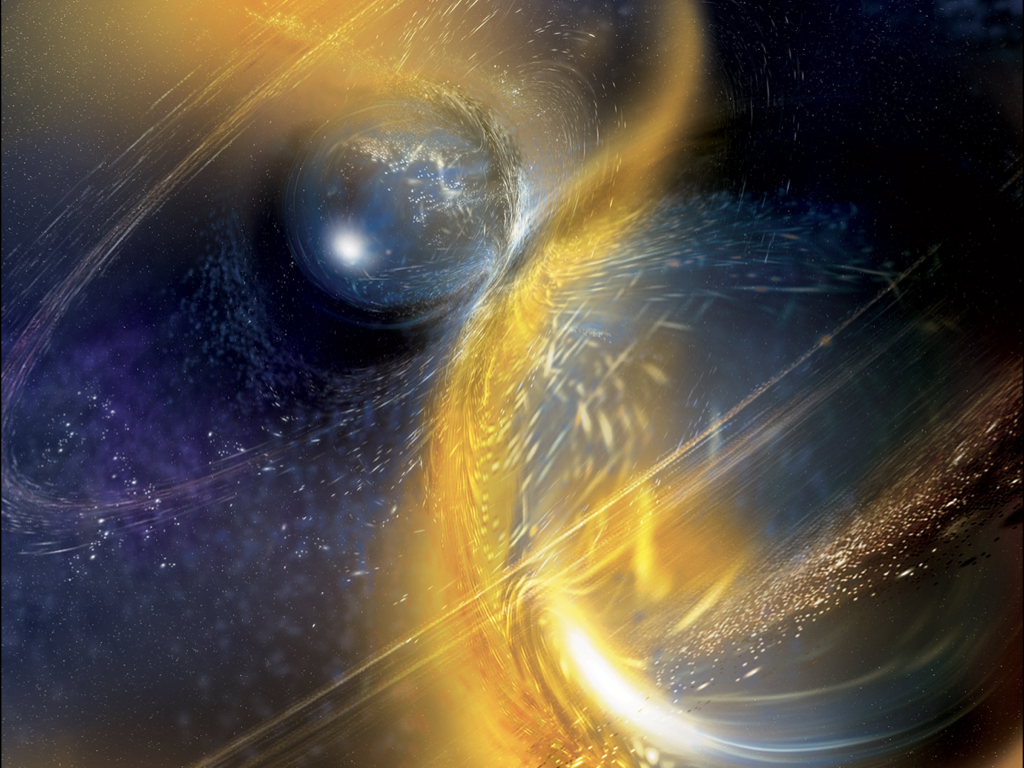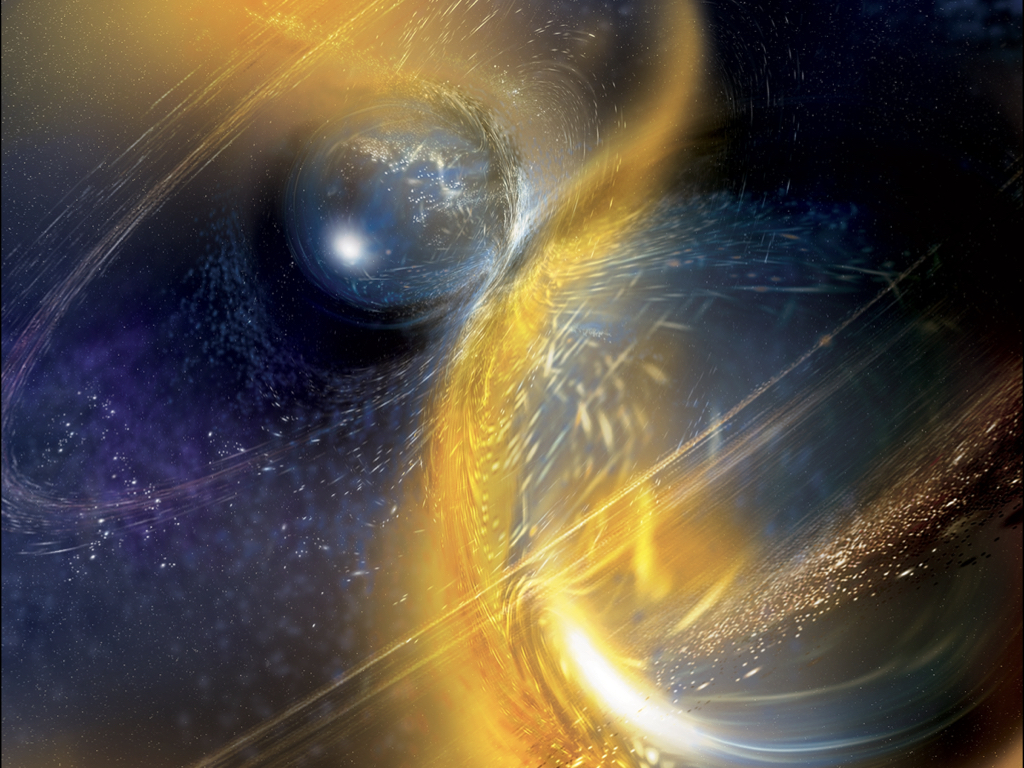Neutron Star Mergers, Part 1: Evidence for Creation
The early twentieth-century discovery of the cosmic expansion rate convinced astronomers that the universe had a beginning. Mounting evidence since then has yielded greater precision of that rate and revealed more details of the cosmic creation event. Recently, the observation of two neutron star merging events has provided more fine-tuning evidence for creation and it promises more to come.
Several years ago, I published an article on GW170817, the first-ever merger of two neutron stars observed by astronomers.1 It was called a “life-changing event” by astronomer Alessandra Corsi. Follow-up observations established that the merger of neutron stars explains the source of nearly all r-process elements (rapid neutron capture elements). R-process elements account for about half the elements heavier than iron—including silver, gold, platinum, palladium, osmium, thorium, and uranium—without which animal life and human civilization would be impossible. A high abundance of uranium and thorium, for example, is needed for a planet to sustain strong plate tectonics and a strong magnetic field for several billion years. Like nearly every other component of the universe, the rate, kinds, timing, and proximity of neutron star merging events must be exquisitely fine-tuned for human civilization to be possible.
The discovery of the neutron star merger would have been impossible without gravity-wave telescopes. On April 25, 2019, the LIGO Collaboration used these telescopes to discover a second neutron star merging event, GW190425 (see figure). The reasoning behind the names is as follows: GW stands for gravitational wave, and the numbers indicate the date of discovery: year, month, day. This group of astronomers published their analysis of GW190425 on March 20, 2020.2 The Max Planck Institute for Gravitational Physics produced a computer-generated video simulation of the event. GW190425 led to a flurry of follow-up research studies over the past weeks and months that has already delivered new evidence for cosmic creation and promises more.

Figure: Simulation of the Binary Neutron Star Coalescence GW190425
Image credit: LIGO Scientific Collaboratioin and the Virgo Collaboration
Cosmic Expansion Rate and Cosmic Creation Date
The merging of two black holes yields observable gravitational waves but not observable electromagnetic radiation. The merging of two neutron stars yields both, which makes possible a measurement of the cosmic expansion rate that is based solely on the assumption that general relativity is the correct model for gravity to high precision. The specific application of this assumption is that general relativity reliably describes the dynamics of two neutron stars in a tight orbit about one another.
One way astronomers have tested this assumption has been through observations of 24 binary black hole merging events.3 These observations yielded eight distinct tests of general relativity (GR). Teams from the LIGO Scientific Collaboration and the Virgo Collaboration who made the observations noted that GR passed all eight tests with flying colors. They wrote, “We find that all of the LIGO–Virgo detections analyzed are consistent with GR, and do not find any evidence for deviations from theoretical expectations, or unknown systematics.”4
This finding is consistent with 35 years of observations of the orbital decay of the two neutron stars that comprise the binary pulsar PSR B1913+16.5 Analysis of 9,257 measurements of times-of-arrival pulses from PSR B1913+16 established that any departure from GR must be less than 5 parts in a quadrillion. Observations of the orbital decay of all other known binary pulsars affirm this conclusion.
Unlike electromagnetic waves, gravitational waves from the merger of two neutron stars encode information about the absolute distance of the source of the gravitational waves, independent of any assumptions about the masses of the stars.6 The observed characteristics of the gravitational waves as two neutron stars spiral in toward one another and merge yields the distance to the two neutron stars.
Unlike gravitational waves, electromagnetic waves emitted from a source encode information about the velocity of the source relative to Earth. Spectral lines in the electromagnetic spectrum of the source will be shifted to longer wavelengths (redshifted) to a degree proportional to the source’s velocity divided by the velocity of light.
Combining the distance derived from the observed characteristics of the gravitational waves from a neutron star merging event with the velocity derived from the observed redshift in a neutron star merging event’s electromagnetic radiation yields the cosmic expansion rate. Analysis of the two neutron star merging events observed so far, GW170817 and GW190425, yields a value for the cosmic expansion rate = 66.2±4.3 kilometers per second per megaparsec.7 (1 megaparsec = 3.26156 million light-years.) This value is not as accurate as the one derived from maps of the cosmic microwave background radiation, which = 67.4±0.5 kilometers per second per megaparsec,8 but is in excellent agreement with it.
Instrument Upgrades Will Provide More Evidence of Creation
With the scheduled upgrades in three existing gravity-wave telescopes and the completion of another two gravity-wave telescopes currently under construction, the predicted detection rate of additional neutron star merging events implies that within five years astronomers will possess a measurement of the cosmic expansion rate accurate to better than 1% precision (possibility of error). This measurement will be free of possible systematic effects (free of untested assumptions) and, thus, more reliable.
A team of four astronomers led by Juan Calerón Bustillo demonstrated that the scheduled and planned upgrades in gravity-wave telescopes will produce enough added sensitivity that astronomers will be able to detect and measure higher-order modes in the gravitational waves from neutron star-merging events.9 Such capability will yield the inclinations of the binary neutron star orbits before the merging event. It will be possible for astronomers to measure the cosmic expansion rate at better than the 1% level based on a single binary neutron star merger detection.
The capability of measuring the cosmic expansion rate at high precision based on a single source means that astronomers will be able to fulfill a long-held dream. That dream: to determine whether or not there are tiny variations in the cosmic expansion rate in proportion to the past history of the universe and/or in proportion to different spatial regions of the universe.
Astronomers already anticipate that, because of dark energy, the cosmic expansion rate will measure slightly less when the universe was young than it is now. Indeed, calculations based on measurements of dark energy predict that the cosmic expansion rate shortly after the cosmic creation event will be about 0.5% less than the present rate.10 The new capability will also enable astronomers to determine whether or not there any inhomogeneities or variations in the dark energy field.11
This advance of measuring the cosmic expansion rate at high precision based on single sources means that astronomers will be able to produce more detailed cosmic creation models. They will also be able to uncover more cosmic design evidences. We can anticipate stronger and additional scientific evidences for a God beyond space and time who has created and crafted the universe for the specific benefit of human beings. We will also gain a more precise and assumption-free measure of the age of the universe.
Next week, I will describe how observations of neutron star merging events have revealed additional design features of the universe, fundamental particles, and the laws of physics that enable humans to live and thrive.
Endnotes
- Hugh Ross, “Neutron Star Merger Explains Why We’re Here (Expanded Version),” Today’s New Reason to Believe (blog), November 3, 2017.
- B. P. Abbott et al., “GW190425: Observations of a Compact Binary Coalescence with Total Mass ~3.4M☉,” Astrophysical Journal Letters 892 (March 20, 2020): id. L3, doi:10.3847/2041-8213/ab75f5.
- B. P. Abbott et al., “Tests of General Relativity with the Binary Black Hole Signals from the LIGO-Virgo Catalog GETC-1,” Physical Review D 100, no. 10 (November 15, 2019): id. 104036, doi:10.1103/PhysRevD.100.104036; LIGO Scientific Collaboration and Virgo Collaboration, “Tests of General Relativity with the Binary Black Holes from the Second LIGO-Virgo Gravitational-Wave Transient Catalog,” Physical Review D 103, no. 12 (June 15, 2021): id. 122002, doi:10.1103/PhysRevD.103.122002.
- LIGO Scientific Collaboration and Virgo Collaboration, “Tests of General Relativity,” page 23 of the preprint, https://arxiv.org/pdf/1903.04467.pdf.
- J. M. Weisberg and Y. Huang, “Relativistic Measurements from Timing the Binary Pulsar PSR B1913+16,” Astrophysical Journal 829, no. 1 (September 20, 2016): id. 55, doi:10.3847.0004-637X/829/1/55.
- Bernard F. Schutz, “Determining the Hubble Constant from Gravitational Wave Observations,” Nature 323, no. 6086 (September 25, 1986): 310–311, doi:10.1038/323310a0; Juan Calderón Bustillo et al., “Mapping the Universe Expansion: Enabling Percent-Level Measurements of the Hubble Constant with a Single Binary Neutron-Star Merger Detection,” Astrophysical Journal Letters 912, no. 1 (April 30, 2021): id. L10, doi:10.3847/2041-8213/abf502.
- Tim Dietrich et al., “Multimessenger Constraints on the Neutron-Star Equation of State and the Hubble Constant,” Science 370, no. 6523 (December 18, 2020): 1450–1453, doi:10.1126/science.abb4317.
- Planck Collaboration, “Planck 2018 Results. VI. Cosmological Parameters,” Astronomy and Astrophysics 641 (September 2020): id. A6, doi:10.1051/0004-6361/201833910.
- Calderón Bustillo et al., “Mapping the Universe Expansion,” id. L10.
- Hugh Ross, “Resolving the Cosmic Expansion Rate Anomaly,” Today’s New Reason to Believe (blog), April 6, 2020.
- Alice Garoffolo et al., “Detecting Dark Energy Fluctuations with Gravitational Waves,” Physical Review D 103, no. 8 (April 15, 2021): id. 083506, doi:10.1103/PhysRevD.103.083506.






